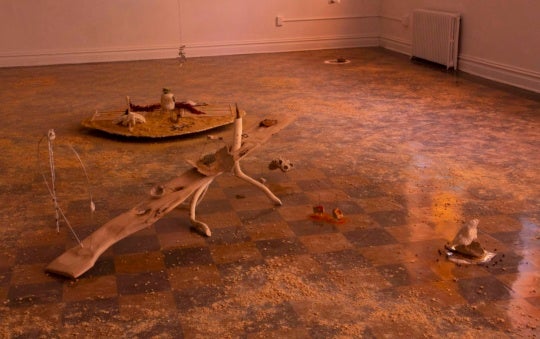In our feature Take Five, Burnaway highlights the work of five compelling artists living in the South. For a special edition of Take Five originally published in Laws of Salvage: The 2020 Burnaway Reader, we asked five curators around the region to briefly profile an artist who captured their attention this year. One of these curators’ picks will be featured on our website each day this week.

In his recent exhibition Forever Yesterday, Johannes Barfield took up travel as both a case study and metaphor for freedom delayed and denied. The earliest work on view, In the Bilge Again (2017), features entries from The Negro Motorist Green Book, first published by Victor Hugo Green in 1936. Sometimes called “the guidebook for freedom,” The Green Book was a compendium of safe travel stops for Black motorists at a time in which the violent policing of Black people was treated as sport. “Bilge” refers to the part of a ship’s hull that sits at the water level, below which commodities might be stored. Concrete and asphalt, two materials used in the construction of roads, become the substrate for the pages of the 1940 Green Book showing listings for Winston-Salem, North Carolina—the artist’s hometown—and Meridian, Mississippi. Two blaring lights separate the listings, a reminder of the dangers that might lie between any two points.
At the center of My Eyes Due See (2018) is a single-channel video in which the artist is seen traveling precariously, affixed to the hood of a moving vehicle. Other materials—found car parts, grass, flashlights, forensic trajectory rods, thick yellow road lines, and pieces of asphalt—tangle together as if the result of a collision. The words “objective reasonableness” flash on the screen intermittently, a reference to the 1989 Supreme Court decision that police force must be “objectively reasonable.” The ruling codified the justification for force when an officer perceives threat or criminality, a legal license for bias and racism still in use today. Together, automotive parts, flashing legal language, sound, and instruments from an ill-fated stop speak to progress inhibited by the grip of violence.
A recent series of multimedia works appropriates images from Marvel comic books in wheat-paste and North Carolina red clay, which Barfield harvests by hand. Each work features the character Lucas Bishop, first introduced in Uncanny X-Men in 1991. The son of mutant Aboriginals, born in a dystopian future Brooklyn, Bishop becomes trapped in the past, where he attempts to prevent the future he has seen. His most notable power is the ability to absorb the energy of others for his own use. It’s hard to not see the resonance between Bishop’s ability and the Black custom of transforming trauma into collective wisdom and power. The collective will of Black people to reshape and reposition our struggle is something like a musical sample; a beat, break, or cut that expresses our desire to make due with our circumstances through skill, vision, and ingenuity.
Amber Esseiva is the associate curator at the Institute for Contemporary Art in Richmond, Virginia.




